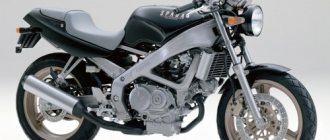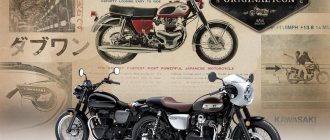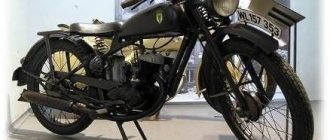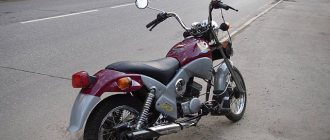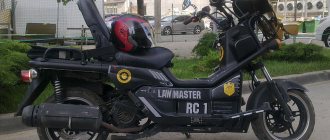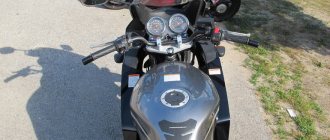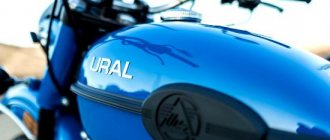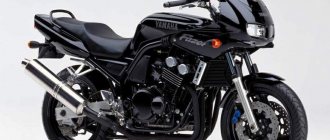| Honda CBX1000 (CBX-Z), 1979 | Honda CBX1000 (CBX-A), 1980 | Honda CBX1000 (CBX-B), 1981 | Honda CBX1000 (CBX-C), 1982 |
Motorcycle model Honda CBX1000
was officially introduced in December 1978 and was positioned as a super sports model intended for racing (Honda even supplied CBX models to the Isle of Man TT between 1979 and 1980). However, the weak frame, brakes, suspension, and, in general, not the most outstanding chassis prevented the model from fully revealing its sporting potential, and by 1981, Honda transferred the CBX1000 to the category of sports-touring versions.
However, the main feature of the Honda CBX1000 is the use of an in-line 6-cylinder air-cooled engine with a volume of 1047 cm³, producing up to 105 hp. power. The engine has 4 valves per cylinder and is equipped with six constant-vacuum carburetors. At the time of its release, the motorcycle set a speed record of 225 km/h and traveled 400 m in 11.65 seconds.
1979 models were factory designated CBX-Z
, featuring silver-colored wheels and a maximum engine power of 105 hp.
In 1980, the model changed slightly, receiving black wheels, a larger oil cooler and other cylinder head adjustments, which reduced the maximum power to 103 hp. Factory designation - CBX-A
.
1981 was marked by a serious restyling of the Honda CBX1000 model (factory code - CBX-B
). From this generation, the model becomes a full-fledged sports tourer with a plastic fairing and side panniers. Ergonomics and weight-dimensional characteristics are changing. The rear suspension gets a Pro-Link progression and is equipped with a pneumatic monoshock absorber (instead of two shock absorbers). The braking system becomes 2-piston front and rear (instead of 1-piston). The fuel tank capacity increases from 20 to 22 liters. Maximum engine power is reduced to 100 hp.
1982 was the last year of production of the model, during which the motorcycle remained virtually unchanged. The only external difference from last year's model was the presence of a plastic handle behind the passenger seat. Factory designation - CBX-C
.
The Honda CBX1000 model was an export model and was intended mainly for the markets of North America and Europe. North American and European versions differ from each other in the ergonomics of the clip-ons and footrests.
Brief history of the model
- 1979 - start of production and sales of the model. First generation
.
Model
: Honda CBX 1000 (Europe, North America).
Frame number:
CB120~.
Model code
: CBX-Z.
- 1980 - minor changes to the model.
Model
: Honda CBX 1000 (Europe, North America).
Frame number:
SC03~.
Model code
: CBX-A.
- 1981 - restyling of the model. Second generation
.
Model
: Honda CBX 1000 (Europe, North America).
Frame number:
SC06~.
Model code
: CBX-B.
- 1982 is the last year of production.
Model
: Honda CBX 1000 (Europe, North America).
Frame number:
SC06~.
Model code
: CBX-C.
Moto Martin CBX[edit]
Moto Martin in CBX frame
In 1980, [16] Frenchman Georges Martin of the French firm Moto Martin designed and built a lighter, stiffer nickel tube frame capable of driving the CBX engine, and supplied the chassis as a kit.
The original bike had handling problems when ridden hard and was heavy at 580 lbs (260 kg). Moto Martin solved the handling problems by creating a new sliding chassis. The new frame was stiffer and lighter than the original, and the standard 37mm fork legs were replaced with 42mm versions of Moto Martin forks. A single rear monoshock was mounted horizontally under the seat. With Brembo brakes and a one-piece fiberglass tank/seat/tail section, overall weight was reduced by 80 lb (36 kg). [17] [18] [19] [20]
British Motorcycle News
named the Martin CBX third fastest in its road test statistics table in 1980, with a top speed of 142.9 mph (230.0 km/h), better than two different Dunstall Suzuki models. [21]
- Honda CBX
Specifications
Technical characteristics of Honda CBX1000:
| Model | Honda CBX1000 |
| Motorcycle type | road/sports tourer |
| Year of issue | 1979-1982 |
| Frame | steel |
| engine's type | 6-cylinder, 4-stroke, in-line |
| Working volume | 1047 cm³ |
| Bore/Stroke | 64.5 x 53.4 mm |
| Compression ratio | 9.3:1 |
| Cooling | air-oil |
| Number of valves per cylinder | DOHC chain drive, 4 valves per cylinder |
| Fuel supply system | Carburetor, 6x Keihin VD 28 mm |
| Ignition type | fully transistorized |
| Maximum power | 105.0 hp (77.2 kW) at 9000 rpm – CBX-Z 103.0 hp (75.7 kW) at 9000 rpm - CBX-A 100.0 hp (73.5 kW) at 9000 rpm – CBX-B, CBX-C |
| Maximum torque | 86.0 Nm (8.7 kg*m) at 8000 rpm – CBX-Z 85.0 Nm (8.6 kg*m) at 8000 rpm - CBX-A 85.0 Nm (8.6 kg*m) at 7500 rpm – CBX-B, CBX-C |
| Clutch | Multi-disc in oil bath, cable drive |
| Transmission | 5-speed |
| type of drive | chain |
| Front tire size | 3.50H19 (4PR) – CBX-Z, CBX-A 3.50V19 (4PR) – CBX-B, CBX-C |
| Rear tire size | 130/90 V18 |
| Front brakes | 2 discs, 1-piston calipers – CBX-Z, CBX-A 2 discs, 2-piston calipers – CBX-B, CBX-C |
| Rear brakes | 1 disc, 1-piston caliper – CBX-Z, CBX-A 1 disc, 2-piston caliper – CBX-B, CBX-C |
| Front suspension | Telescopic fork with air pumping, travel - 160 mm |
| Rear suspension | Pendulum with two shock absorbers, stroke - 100 mm - CBX-Z, CBX-A Pendulum Pro-Link with pneumatic monoshock absorber, stroke - 105 mm - CBX-B, CBX-C |
| Motorcycle length | 2220 mm – CBX-Z, CBX-A 2365 mm – CBX-B, CBX-C |
| Motorcycle width | 885 mm – CBX-Z, CBX-A 780 mm – CBX-B, CBX-C |
| Motorcycle height | 1175 mm – CBX-Z, CBX-A 1360 mm – CBX-B, CBX-C |
| Wheelbase | 1495 mm – CBX-Z, CBX-A 1535 mm – CBX-B, CBX-C |
| Seat height | 810 mm |
| Minimum ground clearance (clearance) | 150 mm – CBX-Z, CBX-A 155 mm – CBX-B, CBX-C |
| Acceleration 0-100 km/h (0-60 mph) | 4.6 sec[1] |
| Maximum speed | 217 km/h[2] |
| Gas tank capacity | 20.0 l (including reserve – 5.0 l) – CBX-Z, CBX-A 22.0 l (including reserve – 3.0 l) – CBX-B, CBX-C |
| Motorcycle weight (dry) | 249 kg – CBX-Z, CBX-A 287 kg – CBX-B, CBX-C |
Reception [edit]
In the February 1978 issue of Cycle (magazine), editor Cook Neilson wrote about revising the pre-production bike, after reviewing four days at Orange County Raceway, Willow Springs Raceway, and a Webco dynamometer: "The goal is to build the fastest production motorcycle for sale anywhere." peace - was fulfilled." [12] Comparing the CBX to the CB900F, Setright added: “The CBX feels and rides better, and the difference is larger than the price difference, so the more expensive bike is actually a better deal. … The CBX engine is better.” as responsive as a racer, the nicest motorcycle engine to ever hit the street." [eleven]
The CBX was the predecessor to the 1972–1978 six-cylinder Benelli 750 Sei based on the Honda CB500 Four, but it was the latest and most advanced entry into the competitive superbike market. Review in Cycle
called the CBX a "breakthrough for the Japanese motorcycle industry" and praised its design, concept and performance. [13] The CBX was available on the market in late 1978, and the production model was even faster than the prototype. [8] Cycle World posted a 1/4 mile time of 11.64 seconds at 117.95 mph (189.82 km/h). The 1978 bike was also the first motorcycle tested to exceed 130 mph (210 km/h). [1] The 1979 CBX could run the quarter mile in 11.36 seconds with a top speed of 117.95 mph (189.82 km/h). [14] But later CBXs with the addition of saddlebags and fairing were upset and revealed that the 1981 CBX had lost five hp. compared to the 1978 model, from 105 to 100 hp. [7] [6]
Cycle Guide
named the bike the 1979 Vincent Black Shadow upon its introduction.
[15] In 2011, Australian publication 2 Wheels Magazine
named the CBX one of its 12 favorite superbikes.
To avoid confusion with Honda CBX series bikes, the CBX is sometimes called the CBX1000
.
Honda CBX 125
| To the page. |
Honda motorcycles are successfully sold all over the world.
Every year there are more and more fans of this technique. Over the course of several years, the concern has transformed from a manufacturer of cheap mopeds into the main supplier of motorcycle equipment on the international market. The success of this brand is associated with the maximum concern of the manufacturers for the safety of the pilot while driving. Much attention is paid to the technical equipment of the bikes and their design.
In 1983, the updated Honda CBX 125 was presented to the general public. The model turned out to be compact, without unnecessary parts and body kit, it can be classified as a cruiser. This new product has the usual four-stroke engine for this line of motorcycles, equipped with one cylinder with four valves.
The cylinder head contains a pair of camshafts. The power unit has an air cooling system. The useful volume of the installation is 124 cm3. The cylinder diameter is 55 mm and the piston stroke is 47 mm.
If you compare this Honda CBX 125 with a 1982 bike, the difference will be in the type of carburetor. Other characteristics are almost identical. The motorcycle is equipped with an electric starter and a CDI ignition system. The engine produces a maximum power of 17 hp. at 11500 rpm.
Maximum torque is 1.1 Nm at 8500 rpm. This torque is transmitted to the rear wheel using a five-speed transmission equipped with a chain drive. Changes were made to the dimensions and gas tank of the device.
The front wheel has acquired a size of 18 inches, the rear - 16. The height of the saddle is now 770 mm, the volume of the fuel tank has decreased to 10 liters. In addition, the dry weight of the bike is different; it weighs 114 kg.
The motorcycle is designed for daily trips in the city. Getting to work with it is very convenient, fast and safe. The driver can easily handle the controls and get maximum pleasure from the ride.
Manufacturers recommend operating the bike in a gentle manner and paying due attention to its maintenance. Proper care significantly extends the life of the device.
Technical characteristics of Honda CBX 125: Type: road motorcycles; Year of manufacture: 1983; Engine type: 4-stroke, single-cylinder, DOHC; Engine capacity, cm3: 124; Motor power, hp: 17; Transmission: 5-speed, chain; Compression ratio: 11:1.
000_moto_0811_022
Honda CBX666 The Beast: retro racing bike, 1147 cm³, 130 hp, 227 kg.
Honda CBX666 The Beast: retro racing bike, 1147 cm³, 130 hp, 227 kg.
There are few racing motorcycles as spectacular as the Honda CBX666 superbike, also known as The Beast. And effective: you should have seen how Michael Dibb finished just a split second behind the winner in the Vintage Superbike race. “The finish line was not drawn there,” Mike later lamented, “otherwise I would have gotten him!”
I had the chance to try out this unusual motorcycle during the Broadford Bike Bonanza festival (see “Moto” No. 1–2011). And despite the wide six-cylinder engine, it was quite nimble even on this narrow and winding road. And when 130 hp. a forced and overbored engine tends to cling to the asphalt through a wheel that is only 4.5 inches wide (according to the rules for Vintage Superbike, you can’t do more), we can only thank the series organizers for at least allowing the use of slicks.
This whole story began in 1982, when a young Australian, Roland Skate, bought himself a well-worn Honda CBX. “I just fell in love with this motorcycle: so much dynamics and excitement,” Roland recalls with a smile. “I started going to track days, and then I got up the courage to take part in races. After my first trip to the competition, in 1994, I began to little by little modify and improve my bike. It all ended when a valve broke at the 2003 Island Classic and my CBX slid on its side, crushing the crankcase. After that, I decided that it would be better to find someone younger and more talented for racing - so I began to collaborate with Michael Dibb.”
A couple of club races convinced the partners that the standard chassis was no good: slick tires allow the motorcycle to corner on turns, but the frame does not. But here there would be no happiness, but misfortune helped. American Honda CBX specialist Tom Marquart came to Australia in 2008 to take part in the races, but he became so decomposed that he had to rest for three weeks - in Skate’s house. In gratitude, Tom took the CBX frame from Roland to convert it into a racing frame in the USA.
When the frame returned home, Skate installed a lightweight and boosted motor in it. The production Honda CBX engine with carburetors weighs 102 kg - so Roland cut off the starter and generator and installed a crankshaft that was 3 kg lighter. Alas, that crankshaft was damaged when the engine seized up - it turned out that at the angles of inclination that are possible on slicks and with a new frame, oil starvation occurs. Therefore, Skate deepened the sump by 30 mm, and now the lubrication system holds 6 liters of oil instead of the stock 4.5. Roland also supplied an HRC kit oil cooler for the CB1100RB, steel Carrillo connecting rods and Wiseco pistons with a diameter increased by 3 mm, and the displacement increased from stock 1047 to 1147 cm³. Thanks to a thin gasket, the compression ratio was raised to 10.5 - it seems a little, but in stock it was only 9.3. The modified cylinder head contains stainless steel valves (made in China) of increased diameter - 26.5 mm for intake, 23 mm for exhaust (in stock - 25/22). Racing camshafts - from Californian.
How much does all this weigh? 227 kg in running order, with ten liters of gasoline in the stock steel tank. Wheel weight distribution of 46/54% is not ideal, but much better than the stock CBX. This colossus is stopped by floating cast iron Ford McKernan discs, paired with two-piston Brembo calipers taken from a broken Benelli Sei - this is how one “six” helped the other.
Externally, The Beast is a real lion among motorcycles, and this impression is not deceiving. The device is very high - to maintain side clearance in turns - and the landing position is such that you load the Tingate handlebar clip-ons with your weight. They are wide apart - on an 80's superbike you need a lot of weight on the handlebars to get the bike into corners. However, on the move the bike does not seem so bulky - although the transverse “six” enthusiastically rams the air on high-speed straights. This even has its advantages: you hide your legs behind the outer cylinders, spread out on the gas tank and hide your head behind the number plate - this is your path to aerodynamic perfection for a naked bike!
But most of all I was surprised by the handling of the motorcycle - even at apexes you don’t have to lean too much on the steering wheel. The brakes are also good: locally made cast iron Ford McKernan wheels are much better than the Japanese stainless steel wheels of the 1980s. In addition, the weight distribution helps maintain stability during sudden braking, and the multi-cylinder engine is not prone to locking the rear wheel when releasing the gas suddenly.
While more powerful four-cylinder rivals have a rather nervous character, the 130-horsepower The Beast impresses with its friendliness and linear performance. The six-cylinder engine comes to life at 5800 rpm, passes the torque peak at 7200 rpm and pulls all the way to 10,400 rpm when redline is engaged. This thrust is accompanied by the melodic musical accompaniment of two Megacycle mufflers. However, I would have preferred a less friendly, but more explosive character - I have to wait too long for the engine to rev up when exiting corners. A lighter crankshaft, higher compression ratio and sharper camshafts - and Michael Dibb will be proud of race victories, not worthy defeats.
Alas, the second run ended when the cylinder mounting pin broke. Behind it, the camshaft drive chain broke, and although I instantly responded to the changed engine note by squeezing the clutch, I ended up with 18 bent valves (out of 24) - now do you understand why Roland buys them in China? But I had enough time to be convinced of the merits of this device. One can only wonder: why didn’t Honda build an endurance racing motorcycle based on it back then, in the late 70s? Of course, six cylinders consume more, so the power is higher. And most importantly - such smooth operation! Which is not superfluous at all when you drive this car for 24 hours...
“I started building The Beast in 1993, but only in recent years has it really taken off,” comments Roland Skate. “And now my plans are to build The Beast II - with a Pro-Link chassis and a 1233 cm³ engine running on methanol. And this is where Dibb will definitely be the first to cross the finish line!”
002_moto_0811_022
The frame vaguely resembles the production one, but in fact it is a special racing version built by Tom Marquart, the engine sits 25 mm higher and 15 mm closer to the front wheel than stock, and the steering angle has been reduced from 27.5 to 23 degrees.
The frame vaguely resembles the production one, but in fact it is a special racing version built by Tom Marquart, the engine sits 25 mm higher and 15 mm closer to the front wheel than stock, and the steering angle has been reduced from 27.5 to 23 degrees.
CBX 125 F
Honda motorcycles are successfully sold all over the world. Every year there are more and more fans of this technique. Over the course of several years, the concern has transformed from a manufacturer of cheap mopeds into the main supplier of motorcycle equipment on the international market.
The success of this brand is associated with the maximum concern of the manufacturers for the safety of the pilot while driving. Much attention is paid to the technical equipment of the bikes and their design.
In 1983, the updated Honda CBX 125 was presented to the general public. The model turned out to be compact, without unnecessary parts and body kit, it can be classified as a cruiser. This new product has the usual four-stroke engine for this line of motorcycles, equipped with one cylinder with four valves.
